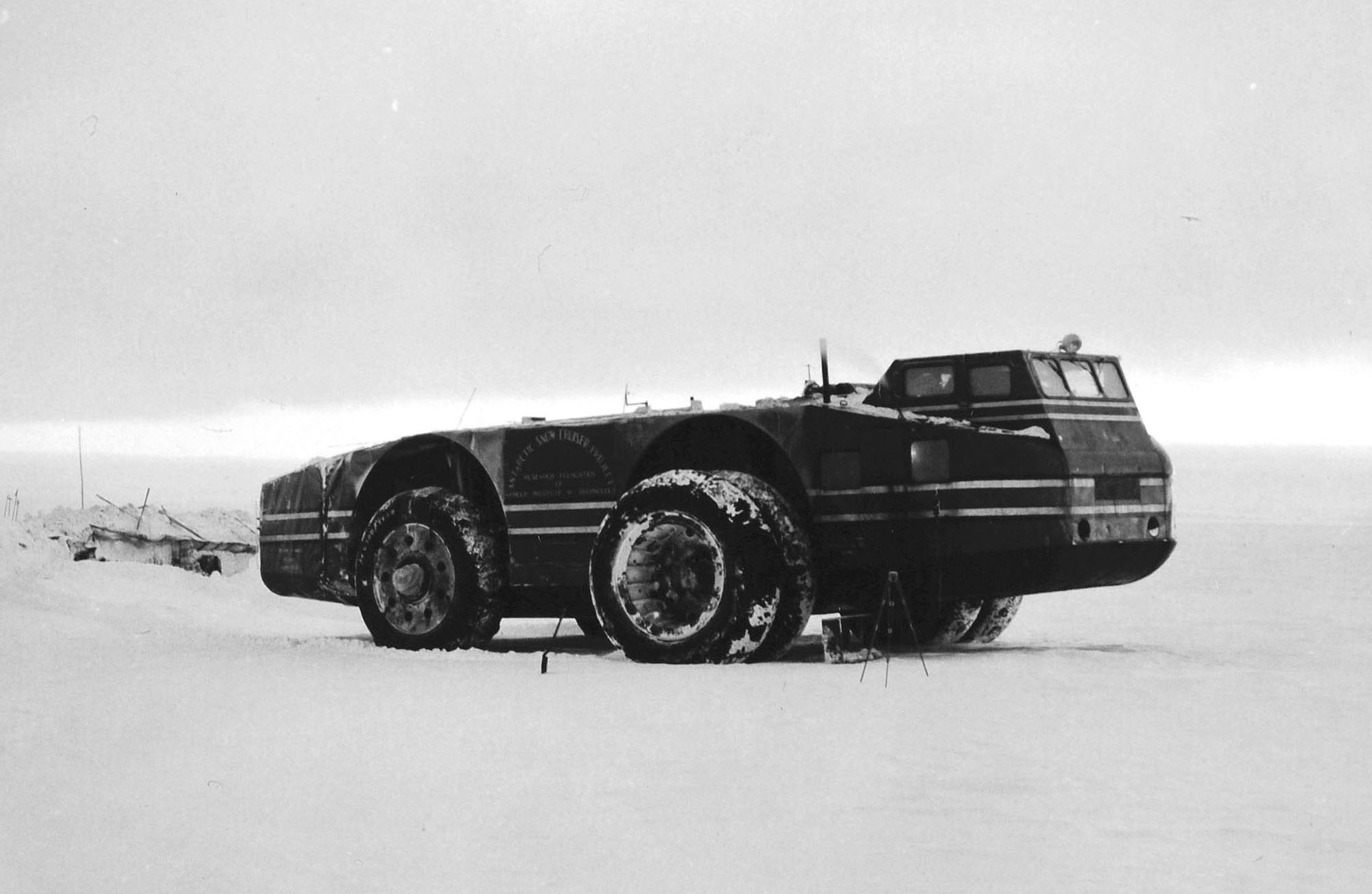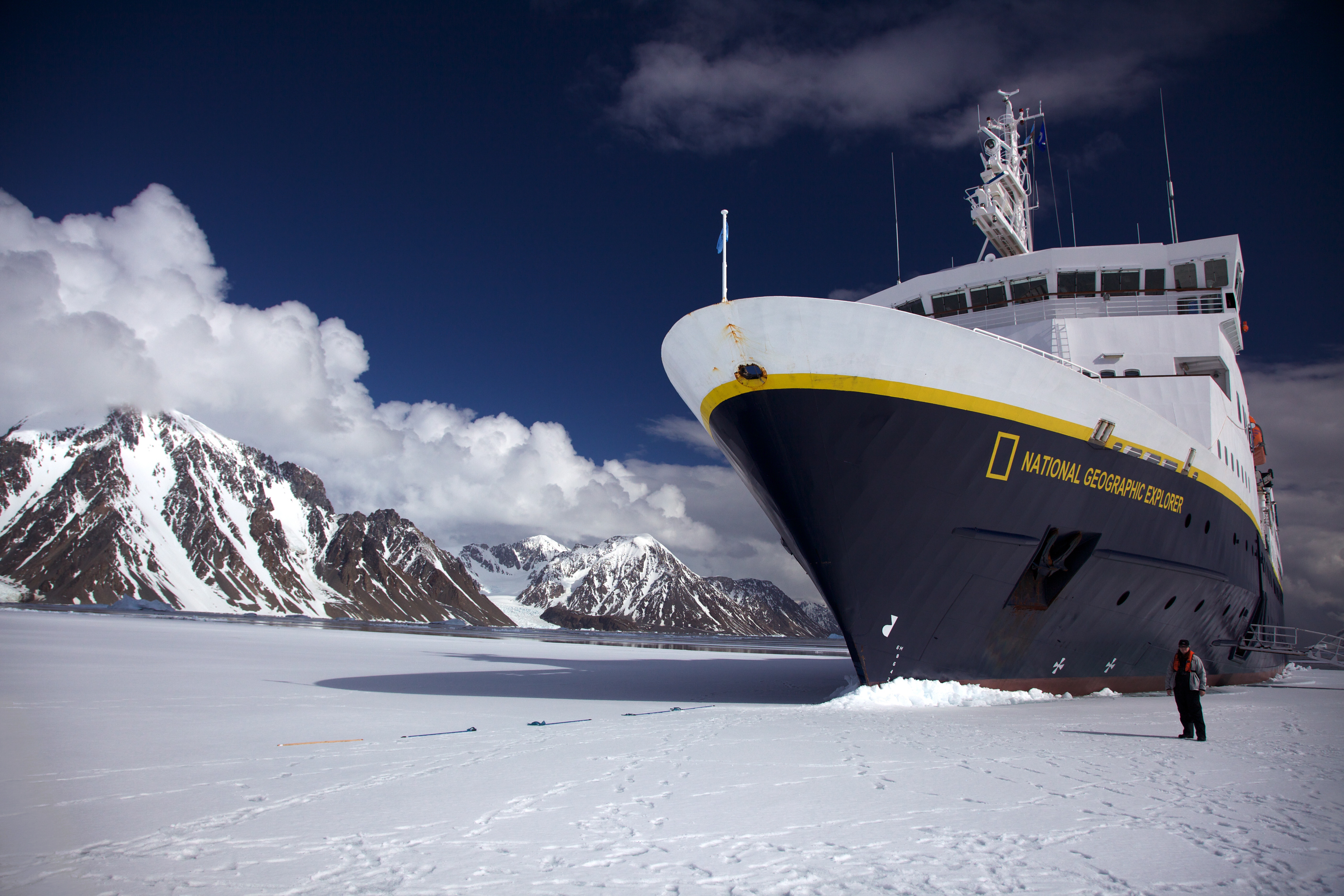|
Kharkovchanka
Kharkovchanka (Russian: Харьковчанка, "Woman of Kharkov"), code name: Manufacture 404S, is a model of Antarctic off-road vehicle made circa 1957–1958 in the Soviet Union, designed and built by the Kharkov Transport Engineering Plant, and later manufactured in Kharkiv by the Malyshev Factory. Based on the AT-T tractor platform (itself based on the T-54 tank). In December 1959 two of them ("21" and "23") were delivered to Antarctica and reached the South Pole. The massive off-road snow vehicle had a small galley, toilet, oven, and eight beds. By the 39th Russian Antarctic expedition, Vityaz DT-30Ps replaced the Kharkovchankas. Those were themselves later replaced by 300 Polar vehicles. History Three Kharkovchankas were built in 1958, and shipped to Antarctica. They traversed from the ocean coast to the existing Soviet Vostok Station in February 1959. Two of these, and a third AT-T tractor, left Vostok station for the geographic South Pole in early December 1959, a ... [...More Info...] [...Related Items...] OR: [Wikipedia] [Google] [Baidu] |
Malyshev Factory
The Malyshev Factory ( uk , Завод імені В.О. Малишева, translit=Zavod imeni V.O. Malysheva; abbreviated ), formerly the Kharkov Locomotive Factory (, ), is a state-owned manufacturer of heavy equipment in Kharkiv, Ukraine. It was named after the Soviet politician Vyacheslav Malyshev. The factory is part of the State Concern UkrOboronProm ( Ukrainian Defense Industry). It produces diesel engines, farm machinery, coal mining, sugar refining, and wind farm equipment, but is best known for its production of Soviet tanks, including the BT tank series of fast tanks, the famous T-34 of the Second World War, the Cold War T-64 and T-80, and their modern Ukrainian successor, the T-84. The factory is closely associated with the Morozov Design Bureau (KMDB), designer of military armoured fighting vehicles and the Kharkov Engine Design Bureau (KEDB) for engines. During 1958 it constructed "Kharkovchanka", an off-road vehicle which reached the South Pole the following year ... [...More Info...] [...Related Items...] OR: [Wikipedia] [Google] [Baidu] |
Kharkov Transport Engineering Plant
The Ministry of Transport Machine-Building Industry (russian: Министерство транспортного машиностроения СССР) was one of the government ministries of the Soviet Union. Before 1946 it was known as the People's Commissariat of the Tank Industry of the USSR (''Народный комиссариат танковой промышленности СССР''). The seat was located in Moscow at Ryazanskaya St. (''Рязанская ул.'') 8а, then evacuated to Chelyabinsk. History The People's Commissariat of the Tank Industry was created 11 September 1941 on the basis of People's Commissariat of Middle Engineering Industry in conjunction with those of large losses of tanks in World War II. Similar commissariats existed at that time in other areas of the defense industry, such as aviation and NKTP was organized similarly. NKTP became one of the largest industrial ministries of the USSR. It consisted of a series of industrial giants, employing ... [...More Info...] [...Related Items...] OR: [Wikipedia] [Google] [Baidu] |
4th Soviet Antarctic Expedition
The Fourth Soviet Antarctic Expedition was an expedition in Antarctica led by Aleksandr Gavrilovich Dralkin. According to '' Soviet News'': :The expedition ... made a scientific trek from the shores of the Indian Ocean to the Geographical South Pole and back, covering a distance of nearly 2500 miles to the Vostok Station. See also * Soviet Antarctic Expedition * Kharkovchanka Kharkovchanka (Russian: Харьковчанка, "Woman of Kharkov"), code name: Manufacture 404S, is a model of Antarctic off-road vehicle made circa 1957–1958 in the Soviet Union, designed and built by the Kharkov Transport Engineering Plant ... References # Eds (June 1960) "The Record" in ''The Geographical Journal''. 126(2):248–55 04 Soviet Antarctic Expedition 04 Soviet Antarctic Expedition 04 Soviet Antarctic Expedition 04 1958 in Antarctica 1959 in Antarctica 1960 in Antarctica {{antarctica-stub ... [...More Info...] [...Related Items...] OR: [Wikipedia] [Google] [Baidu] |
AT-T
Artilleriyskiy Tyagach Tyazholiy, or AT-T (russian: Артиллерийский Тягач, Тяжёлый (АТ-Т), meaning "heavy artillery tractor") was a Soviet Cold War-era artillery tractor. The AT-T is based on the chassis and drive system from the T-54 tank. However, the hull has been rotated 180 degrees, with the engine, clutch, gearbox, steering gear and the drive wheels located at the front of the vehicle. The crew cabin is also located in the front part of the vehicle, and is from the ZIS-150 and ZIL-164 trucks. Variants *BAT-M obstacle removing vehicle *BTM-3 high-speed trench digging vehicle *Kharkovchanka Antarctic off-road vehicle *MDK-2M pits digging vehicle *P-40 radar The P-40 "Armour" or 1S12 (also referred to by the NATO reporting name "Long Track" in the west) is a 3-D UHF radar developed and operated by the former Soviet Union. Development The P-40 started development in 1960 and by 1962 the radar had c ... External links O. Protasov - AT-T heavy ar ... [...More Info...] [...Related Items...] OR: [Wikipedia] [Google] [Baidu] |
Antarctic Snow Cruiser
The Antarctic Snow Cruiser was a vehicle designed from 1937 to 1939 under the direction of Thomas Poulter, intended to facilitate transport in Antarctica during the United States Antarctic Service Expedition (1939–41). The Snow Cruiser was also known as "The Penguin," "Penguin 1" or "Turtle" in some published material. Poulter had been second in command of Richard E. Byrd#Second Antarctic Expedition, Byrd's Second Antarctic Expedition, launched in 1934. From his time in the Antarctic, Poulter had devised several innovative features. The massive Snow Cruiser generally failed to operate as hoped under the difficult conditions (the tires, notably smooth to avoid becoming snow encrusted, did not grip the ice) and was eventually abandoned in Antarctica. Rediscovered under a deep layer of snow in 1958, it later disappeared again due to shifting ice conditions. History Design and construction On April 29, 1939, Poulter and ''The Research Foundation of the Armour Institute of Techno ... [...More Info...] [...Related Items...] OR: [Wikipedia] [Google] [Baidu] |
Geographic South Pole
The South Pole, also known as the Geographic South Pole, Terrestrial South Pole or 90th Parallel South, is one of the two points where Earth's axis of rotation intersects its surface. It is the southernmost point on Earth and lies antipodally on the opposite side of Earth from the North Pole, at a distance of 12,430 miles (20,004 km) in all directions. Situated on the continent of Antarctica, it is the site of the United States Amundsen–Scott South Pole Station, which was established in 1956 and has been permanently staffed since that year. The Geographic South Pole is distinct from the South Magnetic Pole, the position of which is defined based on Earth's magnetic field. The South Pole is at the centre of the Southern Hemisphere. Geography For most purposes, the Geographic South Pole is defined as the southern point of the two points where Earth's axis of rotation intersects its surface (the other being the Geographic North Pole). However, Earth's axis of rotation ... [...More Info...] [...Related Items...] OR: [Wikipedia] [Google] [Baidu] |
Transport In Antarctica
Transport in Antarctica has transformed from explorers crossing the isolated remote area of Antarctica by foot to a more open era due to human technologies enabling more convenient and faster transport, predominantly by air and water, but also by land as well. Transportation technologies on a remote area like Antarctica need to be able to deal with extremely low temperatures and continuous winds to ensure the travelers' safety. Due to the fragility of the Antarctic environment, only a limited amount of transport movements can take place and sustainable transportation technologies have to be used to reduce the ecological footprint. The infrastructure of land, water and air transport needs to be safe and sustainable. Currently thousands of tourists and hundreds of scientists a year depend on the Antarctic transportation system. Land transport Roads Winds continuously blow snow on roads in Antarctica. The South Pole Traverse (McMurdo–South Pole highway) is approximately long ... [...More Info...] [...Related Items...] OR: [Wikipedia] [Google] [Baidu] |
Off-road Vehicles
An off-road vehicle, sometimes referred to as an overland or adventure vehicle, is considered to be any type of vehicle which is capable of off-roading, driving on and off Pavement (material), paved or gravel surface. It is generally characterized by having large tires with deep, open treads, a flexible suspension (vehicle), suspension, or even caterpillar tracks. Other vehicles that do not travel on public streets or highways are generally termed off-highway vehicles, including tractors, forklifts, Crane (machine), cranes, backhoes, bulldozers, and golf carts. Off-road vehicles have an enthusiastic following because of their versatility. Several types of motorsports involve racing off-road vehicles. The most common use of these vehicles is for tourism, sightseeing in areas distant from the Pavement (material), pavement. The use of higher clearance and higher traction vehicles enables access on trails and forest roads that have rough and low traction surfaces. Off-road vehicles ... [...More Info...] [...Related Items...] OR: [Wikipedia] [Google] [Baidu] |
Soviet Automobiles
The Soviet Union,. officially the Union of Soviet Socialist Republics. (USSR),. was a List of former transcontinental countries#Since 1700, transcontinental country that spanned much of Eurasia from 1922 to 1991. A flagship communist state, it was nominally a Federation, federal union of Republics of the Soviet Union, fifteen national republics; in practice, both Government of the Soviet Union, its government and Economy of the Soviet Union, its economy were highly Soviet-type economic planning, centralized until its final years. It was a one-party state governed by the Communist Party of the Soviet Union, with the city of Moscow serving as its capital as well as that of its largest and most populous republic: the Russian Soviet Federative Socialist Republic, Russian SFSR. Other major cities included Saint Petersburg, Leningrad (Russian SFSR), Kyiv, Kiev (Ukrainian Soviet Socialist Republic, Ukrainian SSR), Minsk (Byelorussian Soviet Socialist Republic, Byelorussian SSR), Tas ... [...More Info...] [...Related Items...] OR: [Wikipedia] [Google] [Baidu] |
Torsion Bar
A torsion bar suspension, also known as a torsion spring suspension, is any vehicle suspension that uses a torsion bar as its main weight-bearing spring. One end of a long metal bar is attached firmly to the vehicle chassis; the opposite end terminates in a lever, the torsion key, mounted perpendicular to the bar, that is attached to a suspension arm, a spindle, or the axle. Vertical motion of the wheel causes the bar to twist around its axis and is resisted by the bar's torsion resistance. The effective spring rate of the bar is determined by its length, cross section, shape, material, and manufacturing process. Usage Torsion bar suspensions are used on combat vehicles and tanks like the T-72, Leopard 1, Leopard 2, M26 Pershing, M18 Hellcat, M48 Patton, M60 Patton and the M1 Abrams (many tanks from World War II used this suspension), and on modern trucks and SUVs from Ford, Chrysler, GM, Mitsubishi, Mazda, Nissan, Isuzu, LuAZ, and Toyota. Class 8 truck manufacturer Kenworth ... [...More Info...] [...Related Items...] OR: [Wikipedia] [Google] [Baidu] |
Soot
Soot ( ) is a mass of impure carbon particles resulting from the incomplete combustion of hydrocarbons. It is more properly restricted to the product of the gas-phase combustion process but is commonly extended to include the residual pyrolysed fuel particles such as coal, cenospheres, charred wood, and petroleum coke that may become airborne during pyrolysis and that are more properly identified as cokes or char. Soot causes various types of cancer and lung disease. Sources Soot as an airborne contaminant in the environment has many different sources, all of which are results of some form of pyrolysis. They include soot from coal burning, internal-combustion engines, power-plant boilers, hog-fuel boilers, ship boilers, central steam-heat boilers, waste incineration, local field burning, house fires, forest fires, fireplaces, and furnaces. These exterior sources also contribute to the indoor environment sources such as smoking of plant matter, cooking, oil lamps, candles, qu ... [...More Info...] [...Related Items...] OR: [Wikipedia] [Google] [Baidu] |







